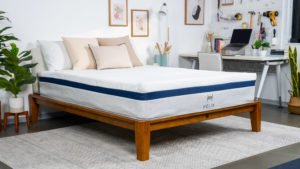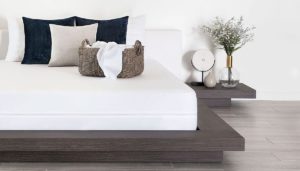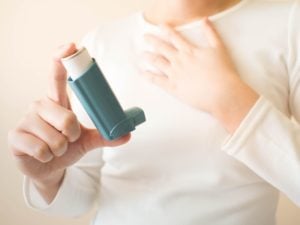Allergens That Impact Sleep
Allergic rhinitis is thought to affect up to 20 to 30% of adults in the U.S. and may be even more common in childhood. Caused by sensitivity to allergens such as dust mites, pet dander, pollen, and mold, allergic rhinitis can have significant effects on sleep and quality of life. We examine the most common allergens, helping you understand your personal triggers so you can better avoid them.

Why Are My Allergies Worse at Night?
In people with allergies, exposure to “trigger” substances like pet dander or dust mites irritates the nasal passages and leads to uncomfortable symptoms such as a stuffy or runny nose, watery eyes, sneezing, and itchiness around the mouth or other sensitive areas. These common irritants are commonly found in the bedroom, and in our bedding. Pillows and bedspreads house dust mites and pet dander, making allergy symptoms flare up. To avoid this, be sure to wash your bedding, including your pillows, frequently.
Nasal congestion is often worse at night, and certain allergy medications can also interfere with sleep. As a result, people with allergies often experience insomnia, nighttime awakenings , and daytime sleepiness. They’re also at risk for co-existing conditions such as nighttime awakenings and sleep-related breathing disorders.
What are the Most Common Allergies That Affect Sleep?
Nighttime allergens can be seasonal or year-round, and may vary depending on where you live. The most common culprits are dust mites, pollen, mold, pets, and cockroaches.
Dust Mites
Dust mites are one of the most common household allergens and one of the first allergies to appear in young children . These tiny creatures feed on dead skin cells and are often found in mattresses, pillows, and box springs. As dust mite allergies are sparked by a build-up of dust, they can occur at any time throughout the year.
Managing dust mite allergies starts by replacing bedroom furniture and accessories that harbor dust. Contrary to popular belief, dust build-up can occur in both feather pillows and synthetic alternatives. Wash your bedding regularly in the hottest water it can handle, and consider buying a sealable cover for your new pillow and mattress to help keep dust mites out.
Heavy curtains, carpets, sofas, and stuffed animals are all potential dust traps. These items should be either deep-cleaned or replaced with more sterile options such as laminate or hardwood floors, blinds, or non-upholstered furniture.
Dusting your house regularly can help prevent a build-up of dust mites. Don’t forget to check filters on vacuums, air conditioning, and heating units, cleaning and replacing them when necessary. As with many allergens, a HEPA filter or dehumidifier can help reduce airborne dust levels.
Pollen
Another common allergy is hay fever , caused by a reaction to pollen from trees, grasses, or weeds such as ragweed. Pollen allergies tend to be seasonal, with most people experiencing worse symptoms and reduced sleep quality in the spring, late summer, and early fall depending on the plant in question.
Hay fever is usually worse when the weather is warm and dry. On days with a high pollen count, try to avoid going outside, especially in the morning. You can check the pollen count for your area through sources online, on TV, or on the radio.
Since pollen almost always comes from outside the house, you can minimize the indoor pollen count by closing doors and windows, changing clothes when you come in, drying clothes inside instead of outside, and showering before bed.
Mold
Allergies to mold spores often fluctuate with the seasons, as mold grows better in the cold and damp. The best way to prevent mold is to reduce humidity in your house.
Bathrooms should be well ventilated after taking a shower or bath. If you don’t have a good fan or window, you can help slow the growth of mold by wiping down wet surfaces and fully extending the shower curtain to let it dry. Using a dehumidifier or turning up the heat may also help.
Cleaning mold as soon as it appears is vital to keeping allergies at bay. Check for mold around taps, sinks, shower curtains, refrigerator trays, dish racks, carpets, stuffed animals, and books. Poorly dried clothing and towels may also give off a musty scent.
Pet Dander
One of the most frustrating allergies for many people is an allergy to household pets, or more specifically, the dander from their skin and saliva. Unfortunately, this is one of the most common year-round allergies in the U.S.
People who share a bed with their pet are especially vulnerable to nighttime allergy symptoms, so consider getting your furry companion a comfortable pet bed all for themselves. Since pet dander causes the strongest reactions when transferred by direct contact, try not to let your pet lick your face, don’t rub your eyes after petting them, and always wash your hands after.
Though pet allergies occur year-round, people with pollen allergies should be aware that pets can sometimes track in additional outside allergens, especially in the spring. You can reduce indoor allergen levels by giving your pet frequent baths with a non-allergenic shampoo.
Cockroaches
Proteins found in cockroaches have been known to provoke symptoms similar to hay fever in some people. The proteins are present in the body, the saliva, and even the waste, and can still cause allergies after the cockroach is dead.
Strict hygiene measures can help keep these pests out of your home. This is best accomplished by regularly cleaning the house, aerating damp spaces, sealing off garbage cans and food sources, and never leaving food or dirty dishes lying around.
Household Products and Cigarette Smoke
Exposure to cigarette smoke and certain household products (such as cleaning products with strong odors) has been linked to rhinitis symptoms , but the mechanism may not be due to allergic sensitization, unlike the allergens described above.
Try using unscented soaps and cleaning products, and ask smokers to smoke outside or near a window to reduce your exposure to these triggers.

Still have questions? Ask our community!
Join our Sleep Care Community — a trusted hub of sleep health professionals, product specialists, and people just like you. Whether you need expert sleep advice for your insomnia or you’re searching for the perfect mattress, we’ve got you covered. Get personalized guidance from the experts who know sleep best.
References
14 Sources
-
Koinis-Mitchell, D., Craig, T., Esteban, C. A., & Klein, R. B. (2012). Sleep and allergic disease: a summary of the literature and future directions for research. The Journal of allergy and clinical immunology, 130(6), 1275–1281.
https://pubmed.ncbi.nlm.nih.gov/22867694/ -
Pawankar, R., Bunnag, C., Chen, Y., Fukuda, T., Kim, Y. Y., Le, L. T., Huong, l., O’Hehir, R. E., Ohta, K., Vichyanond, P., Wang, D. Y., Zhong, N., Khaltaev, N., & Bousquet, J. (2009). Allergic rhinitis and its impact on asthma update (ARIA 2008)–western and Asian-Pacific perspective. Asian Pacific journal of allergy and immunology, 27(4), 237–243.
https://europepmc.org/article/med/20232579 -
Romano, M., James, S., Farrington, E., Perry, R., & Elliott, L. (2019). The impact of perennial allergic rhinitis with/without allergic asthma on sleep, work and activity level. Allergy, asthma, and clinical immunology : official journal of the Canadian Society of Allergy and Clinical Immunology, 15, 81.
https://aacijournal.biomedcentral.com/articles/10.1186/s13223-019-0391-9 -
Lee, K. S., Yum, H. Y., Sheen, Y. H., Park, Y. M., Lee, Y. J., Choi, B. S., Jee, H. M., Choi, S. H., Kim, H. H., Park, Y., Kim, H. B., Rha, Y. H., & Korean Academy of Pediatric Allergy and Respiratory Disease (KAPARD) Work Group on Rhinitis (2017). Comorbidities and Phenotypes of Rhinitis in Korean Children and Adolescents: A Cross-sectional, Multicenter Study. Allergy, asthma & immunology research, 9(1), 70–78.
https://pubmed.ncbi.nlm.nih.gov/27826964/ -
A.D.A.M. Medical Encyclopedia. (2018, May 20). Allergies, asthma, and dust., Retrieved November 12, 2020, from
https://medlineplus.gov/ency/patientinstructions/000487.htm -
Siebers, R. W., & Crane, J. (2011). Does bedding affect the airway and allergy?. The international journal of occupational and environmental medicine, 2(2), 65–75.
https://pubmed.ncbi.nlm.nih.gov/23022822/ -
Seidman, M. D., Gurgel, R. K., Lin, S. Y., Schwartz, S. R., Baroody, F. M., Bonner, J. R., Dawson, D. E., Dykewicz, M. S., Hackell, J. M., Han, J. K., Ishman, S. L., Krouse, H. J., Malekzadeh, S., Mims, J. W., Omole, F. S., Reddy, W. D., Wallace, D. V., Walsh, S. A., Warren, B. E., Wilson, M. N., … Guideline Otolaryngology Development Group. AAO-HNSF (2015). Clinical practice guideline: Allergic rhinitis. Otolaryngology–head and neck surgery : official journal of American Academy of Otolaryngology-Head and Neck Surgery, 152(1 Suppl), S1–S43.
https://journals.sagepub.com/doi/10.1177/0194599814561600 -
A.D.A.M. Medical Encyclopedia. (2018, May 27). Allergies, asthma, and pollen., Retrieved November 12, 2020, from
https://medlineplus.gov/ency/patientinstructions/000489.htm -
Tamm, S., Cervenka, S., Forsberg, A., Estelius, J., Grunewald, J., Gyllfors, P., Karshikoff, B., Kosek, E., Lampa, J., Lensmar, C., Strand, V., Åkerstedt, T., Halldin, C., Ingvar, M., Olgart Höglund, C., & Lekander, M. (2018). Evidence of fatigue, disordered sleep and peripheral inflammation, but not increased brain TSPO expression, in seasonal allergy: A [11C]PBR28 PET study. Brain, behavior, and immunity, 68, 146–157.
https://pubmed.ncbi.nlm.nih.gov/29054675/ -
A.D.A.M. Medical Encyclopedia. (2018, May 27). Allergies, asthma, and molds., Retrieved November 12, 2020, from
https://medlineplus.gov/ency/patientinstructions/000488.htm -
Kelly, L. A., Erwin, E. A., & Platts-Mills, T. A. (2012). The indoor air and asthma: the role of cat allergens. Current opinion in pulmonary medicine, 18(1), 29–34.
https://pubmed.ncbi.nlm.nih.gov/22081090/ -
Wallace D. V. (2009). Pet dander and perennial allergic rhinitis: therapeutic options. Allergy and asthma proceedings, 30(6), 573–583.
https://pubmed.ncbi.nlm.nih.gov/20031003/ -
Asthma and Allergy Foundation of America. (2015, October). Cockroach Allergy., Retrieved November 12, 2020, from
https://www.aafa.org/cockroach-allergy/ -
Shargorodsky, J., Garcia-Esquinas, E., Galán, I., Navas-Acien, A., & Lin, S. Y. (2015). Allergic Sensitization, Rhinitis and Tobacco Smoke Exposure in US Adults. PloS one, 10(7), e0131957.
https://journals.plos.org/plosone/article?id=10.1371/journal.pone.0131957





